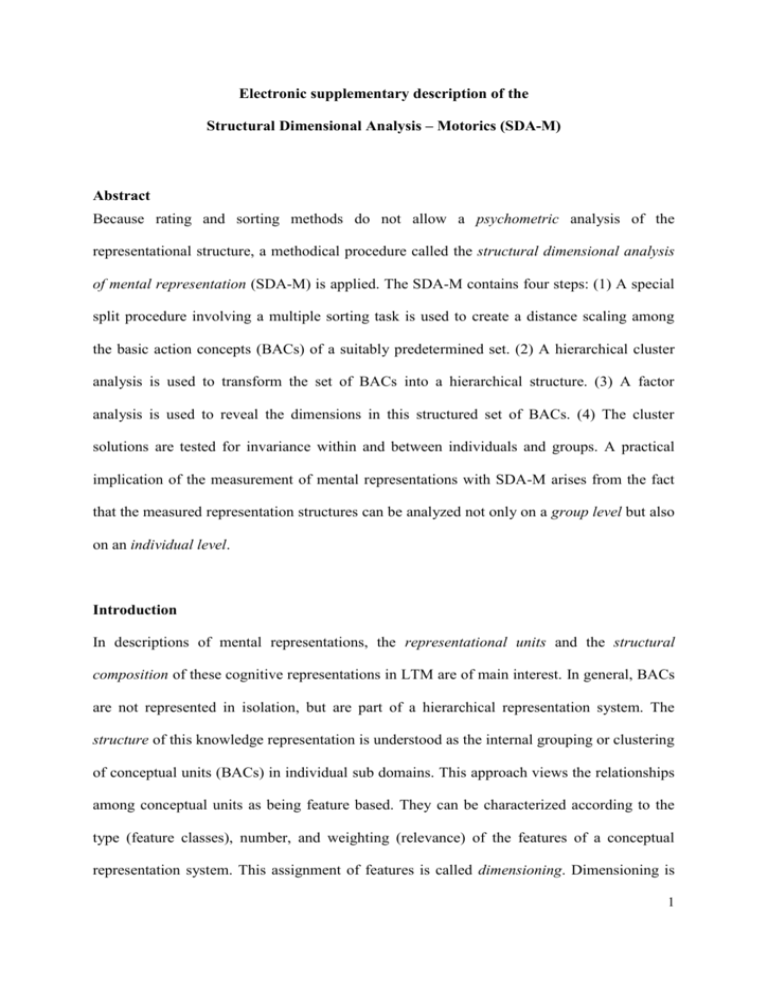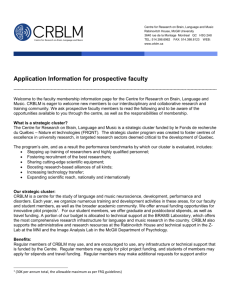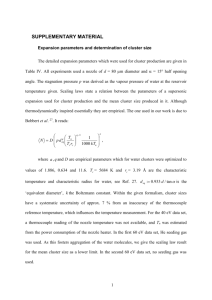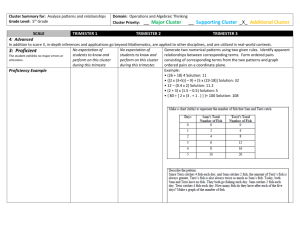Experiment 1 - Springer Static Content Server
advertisement

Electronic supplementary description of the Structural Dimensional Analysis – Motorics (SDA-M) Abstract Because rating and sorting methods do not allow a psychometric analysis of the representational structure, a methodical procedure called the structural dimensional analysis of mental representation (SDA-M) is applied. The SDA-M contains four steps: (1) A special split procedure involving a multiple sorting task is used to create a distance scaling among the basic action concepts (BACs) of a suitably predetermined set. (2) A hierarchical cluster analysis is used to transform the set of BACs into a hierarchical structure. (3) A factor analysis is used to reveal the dimensions in this structured set of BACs. (4) The cluster solutions are tested for invariance within and between individuals and groups. A practical implication of the measurement of mental representations with SDA-M arises from the fact that the measured representation structures can be analyzed not only on a group level but also on an individual level. Introduction In descriptions of mental representations, the representational units and the structural composition of these cognitive representations in LTM are of main interest. In general, BACs are not represented in isolation, but are part of a hierarchical representation system. The structure of this knowledge representation is understood as the internal grouping or clustering of conceptual units (BACs) in individual sub domains. This approach views the relationships among conceptual units as being feature based. They can be characterized according to the type (feature classes), number, and weighting (relevance) of the features of a conceptual representation system. This assignment of features is called dimensioning. Dimensioning is 1 characterized in object concepts through the shared features of objects (e.g., color, size, purpose) or in BACs through the shared properties of movements (e.g., temporal control, amplitude, purpose). Hence, it is not just the structural design of a concept system but also the dimensioning (feature binding and feature weighting) that is of interest. The relationship between these two aspects of a mental representation is also of interest (Lander, 1991; Schack, 2010b). Methodical approaches for measuring mental representations must consider and analyze the structure and feature dimensions of representation. For this reason the method is termed structural dimensional analysis of mental representation (SDA-M). Method Step 1: Splitting technique A primary assumption of the SDA-M (and other methodological approaches to measuring mental representations) is that the structure of movement representations can be explicated only to a limited degree. Thus a splitting technique is used in a first step for this purpose. Each concept is offered as an anchor (i.e., reference object, at the top of the list) to which the remaining N − 1 concepts are either classified or declassified according to an individually chosen similarity criterion (e.g., similarity or dissimilarity between concepts). This procedure continues with the emerging (positive or negative) partial quantities by retaining the reference concept (anchor) until an individual discontinuance criterion is reached. By this procedure N decision trees are established, as each concept occupies an anchor (reference) position (at the top of the list). Subsequently, the algebraic branch sums (Σ) are determined on the partial quantities per decision tree and are submitted to a Z-transformation for standardization and finally combined into a Z-matrix. This matrix forms the starting point of all further analyses. If the Z-values are distributed normally, N(0, 1), then the classification probabilities of the 2 concepts of the reference concept (which are found in the last joint of the decision tree) can be established. In case of our investigation (Stoeckel et al. this issue) the children judged the similarity of all pictures (BACs) with one another (described in full in the paper), which produced positive or negative partial quantities between each amount of pictures (BAC) (family Wusel or family Sauber in relation to the anchoring picture). Because this anchor role of standard was assigned to each picture (BAC) in succession, we ended up with a total of 9 decision trees whose nodes contained the resulting subsets and whose borders took either a negative or positive sign depending on whether the element was judged as belonging to or not belonging to the standard. To obtain a measure of the distance between the successively judged elements and the standard (with interval scaling), algebraic sums were computed over the subsets located on one branch of the decision tree. These sum scores were then z transformed. Step 2: Determination of the hierarchical structure of representation. First, the Z-matrix was transformed into a Euclidean distance matrix for structural analysis, and formed the basis for later hierarchical cluster analysis. As a result of the cluster analysis an individual cluster solution on the N concepts was formed, and depicted as a dendogram. Each cluster solution was established by determining the incidental Euclidean distance (dcrit). All junctures that lay below the incidental value formed the apical pole of an underlying concept cluster. The incidental distance was defined as 𝑑𝑐𝑟𝑖𝑡 = √2𝑁 √1 − 𝑟𝑐𝑟𝑖𝑡 (𝛼, 𝐹𝐺 / H0 : r = 1) where rcrit denotes the incidental value of the correlation of two line vectors of the Z-matrix, provided that H0 is valid. The value for rcrit results from the t-distribution for α (to be determined), with FG = N − 2 degrees of freedom. 3 Step 3: Determination of the feature dimensions of representations. The Z-matrix was transformed into a correlation matrix, and served as the basis for orthogonal factor analysis with a subsequent cluster-oriented rotation procedure. This procedure yielded a factor matrix classified according to the concept cluster, the elements of which were factor charges (c), or property values. A cluster within an individual cluster solution (dendogram) stood out in that its elements (concepts) are at least equally and highly charged. The incidental value for the factor charges based on the factor analysis was defined by 1 𝑐𝑐𝑟𝑖𝑡 = √ 𝑟𝑐𝑟𝑖𝑡 (𝛼, 𝐹𝐺 / 𝐻0 ∶ 𝑟 = 0) 𝑚 where m refers to the number of factors that are to be extracted (estimated a priori). Here rcrit refers to the incidental value of the correlation of the two line vectors from the Z-matrix (assuming that H0 is valid). As in step two, rcrit results from the t-distribution for α, with FG = N − 2 degrees of freedom. This factor matrix formed the final solution of the individual SDAM as a concept quantity. Step 4: Measurement of individual differences between the representations within each group, and determination of the structural invariance (λ) between cluster solutions. The number of made-up clusters of the pair-wise cluster solutions (r, s) was compared with one another. The number of concepts within the made-up clusters (partial quantities nj, nk), and the average quantities of the made up clusters (nik) were used for the structural invariance measure of two cluster solutions, which was determined by 𝜆𝑖𝑘 = √𝑘𝑖𝑘 𝐺𝐴𝑀 (𝑝𝑖𝑘 ) 4 in which 𝑘𝑖𝑘 = 𝑀𝑖𝑛(𝑟,𝑠) 𝑀𝑎𝑥(𝑟,𝑠) , with k0 = 2/3 as a limiting value, 𝑝𝑖𝑘 = 𝑛𝑖𝑘 √𝑛𝑖 𝑛𝑘 , 0 ≤ 𝑝𝑖𝑘 ≤ 1, with p0 = 0.7, and GAM(pik) comprises the weighted arithmetic measures of all relative average quantities (pik). The differential threshold was determined by using the top two interval criteria with λ0 = 0.683. Based on the invariance analysis, an invariance matrix (λ) was established. The clusters represent subgroups of homogenous cluster solutions of the applied concept quantities. The subgroup-specific cluster solutions were determined by summing the Z-matrices of the individuals belonging to the subgroup-specific cluster (following a restandardization of the Z-summary values). Differences between groups were established in a similar fashion. The established structures for each age group were determined by the invariance measure (λ), which can be regarded as sufficient differential criterion if the solutions are found to be of pairwise invariance (Schack, 2004, 2011; Schack & Mechsner, 2006; Schack & Ritter, 2009). Schack, T. (2004). The cognitive architecture of complex movement. International Journal of Sport and Exercise Psychology, 2, 403-438. Schack, T. & Mechsner, F. (2006). Representation of motor skills in human long-termmemory. Neuroscience Letters , 391, 77-81. Schack, T. & Ritter, H. (2009). The cognitive nature of action – Functional links between Cognitive Psychology, Movement Science and Robotics. Progress in Brain Research, 174, 231252. Schack, T. (2011). A method for Measuring Mental Representation. Handbook of Measurement in Sport, pp 203-214. Champaign, IL: Human Kinetics, in press. 5






